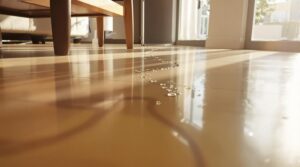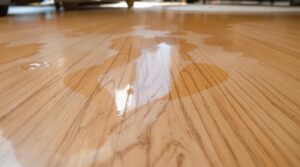Homeowners insurance typically covers sudden and accidental water damage from appliances, such as burst pipes or unexpected leaks. Standard policies exclude damage from gradual deterioration, poor maintenance, or neglect. Coverage applies to damages caused by washing machines, dishwashers, water heaters, and HVAC systems when the incident is abrupt and unforeseen. Documentation of regular maintenance strengthens claims. Understanding the distinction between covered sudden events and excluded gradual damage helps homeowners navigate their policy options effectively. Additionally, homeowners should review their policies to ensure they fully understand the limits and exclusions related to home insurance coverage for water damage. It’s essential to be aware that certain types of water damage, such as flooding from natural disasters, often require separate flood insurance. By being proactive and engaging with their insurance agent, homeowners can tailor their coverage to better protect against unexpected water-related incidents.
Key Takeaways
- Standard homeowners insurance typically covers sudden and accidental water damage from appliances like burst pipes and unexpected leaks.
- Coverage excludes damage from gradual deterioration, poor maintenance, or known but unrepaired leaks.
- Common covered incidents include washing machine hose failures, dishwasher overflows, and water heater ruptures.
- The replacement cost of faulty appliances themselves is typically not covered, only the resulting water damage.
- Claims require immediate reporting, thorough documentation with photos, and proof of regular maintenance to qualify for coverage.
Understanding Home Insurance Coverage for Appliance Water Damage
While homeowners insurance typically covers sudden and accidental water damage from appliances, understanding the specific coverage limitations and exclusions is vital for proper protection.
Standard policies generally include coverage for incidents such as burst pipes, unexpected appliance leaks, and water damage resulting from fires or storms. However, damage caused by neglect or lack of proper appliance maintenance is consistently excluded.
Insurance providers emphasize the distinction between sudden accidents and gradual deterioration. While policies may cover the resulting water damage from a sudden malfunction, they typically exclude the cost of replacing the faulty appliance itself.
Homeowners should be aware that policy specifics can vary greatly, with some offering additional endorsements for hidden water damage or equipment breakdown coverage. Understanding policy limits, deductibles, and maintenance responsibilities is essential for successful claims, as filing water damage claims can potentially impact insurance premiums.
Regular appliance maintenance remains a key factor in preventing claim denials.
Common Types of Appliance Water Damage
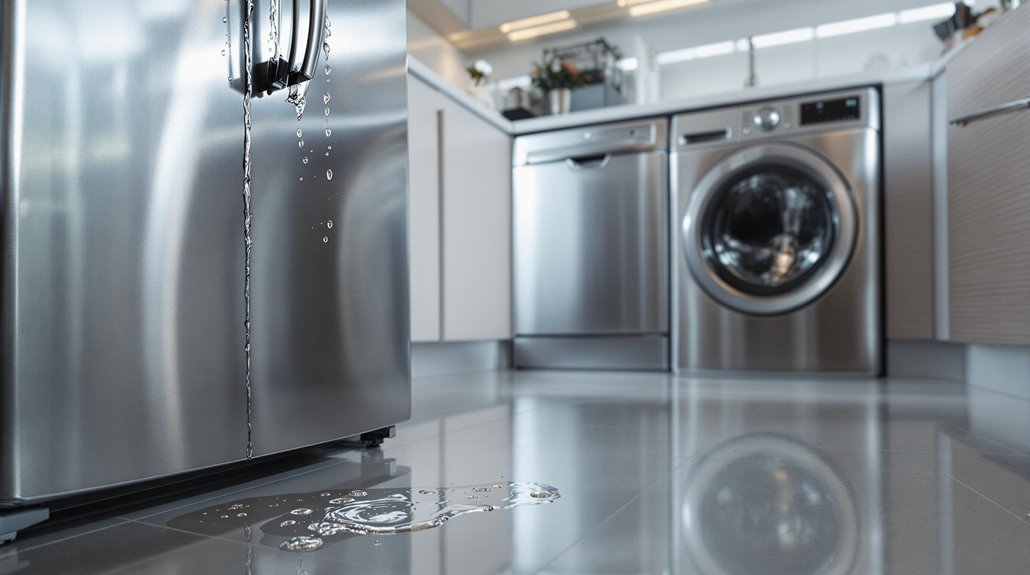
Water damage from household appliances presents distinct patterns and vulnerabilities across different equipment types. Common issues include refrigerator leaks caused by blocked defrost drains or faulty seals, dishwasher issues stemming from worn hoses and improper detergent use, and washing machine malfunctions that can release up to 650 gallons per hour from failed hoses.
Hot water heaters and HVAC problems frequently develop from aging components and inadequate maintenance.
- Refrigerators often leak due to blocked drains, clogged supply lines, or condensation issues.
- Dishwashers typically fail from damaged seals, improper installation, or deteriorated components.
- Washing machines pose risks through loose connections, faulty door seals, and pump failures.
- Hot water heaters develop leaks from pressure buildup and worn valves.
- HVAC systems leak from accumulated mold, poor installation, or refrigerant issues.
Understanding these common failure points enables homeowners to identify potential problems before they escalate into significant water damage events.
Regular inspection and maintenance of these appliances can prevent many water-related incidents.
Sudden vs. Gradual Damage: What's Covered?
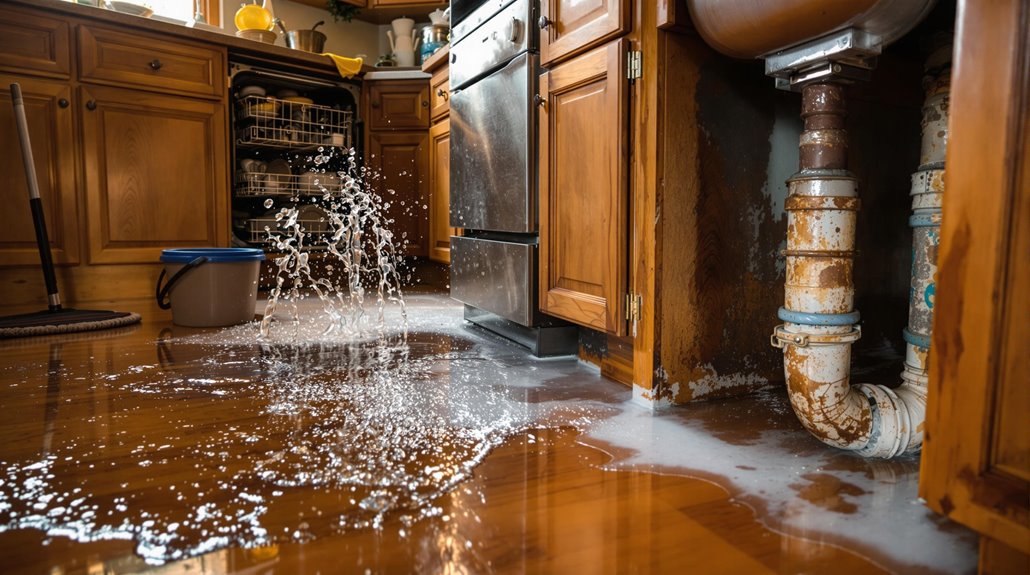
Home insurance policies distinguish between sudden water damage events, such as burst pipes that cause immediate flooding, and gradual damage that occurs over time through continuous leaks or drips.
While sudden and accidental water damage from appliance failures or pipe bursts typically receives coverage, gradual damage from ongoing maintenance issues is generally excluded from standard policies.
Regular maintenance plays a vital role in claim outcomes, as insurers may deny coverage for water damage that results from neglected repairs or known leaks that worsen over time.
Sudden Burst vs. Drips
Insurance providers consistently differentiate between sudden water damage and gradual deterioration when determining coverage eligibility. Sudden leaks from appliance failures, such as burst pipes or ruptured water heaters, typically qualify for coverage under standard home insurance policies. However, damage occurring over time from persistent drips or seepage is generally excluded.
Key distinctions between sudden bursts and drips include:
- Time frame of damage occurrence (immediate vs. gradual)
- Cause of damage (unexpected failure vs. maintenance issues)
- Visibility of the problem (obvious rupture vs. hidden leak)
- Preventability through routine maintenance
- Nature of resulting damage (acute water damage vs. cumulative deterioration)
Understanding these differences is vital for homeowners, as insurance companies carefully evaluate the circumstances surrounding water damage claims before determining coverage eligibility.
Coverage for Immediate Flooding
Three key factors determine whether water damage qualifies for coverage under standard homeowners policies: the suddenness of the event, the source of the water, and the preventability of the damage.
Insurance typically covers sudden water damage from burst pipes, malfunctioning appliances, and ice dams causing structural issues.
However, gradual damage from ongoing leaks, poor appliance maintenance, or external water seepage generally falls outside policy coverage.
While standard policies address specific water-related perils, they exclude damage from natural flooding, groundwater intrusion, and sewer backups.
Homeowners can enhance protection through additional endorsements, including water backup coverage and flood insurance through the NFIP or private carriers.
Properties in high-risk flood zones may require separate flood insurance policies, which typically include a 30-day activation period.
Maintenance Impact on Claims
When evaluating water damage claims, insurance providers distinguish between sudden incidents and gradual deterioration to determine coverage eligibility.
Regular maintenance best practices and proper claim documentation tips are essential for successful claims processing.
Key considerations for water damage claims:
- Insurance companies may deny coverage if damage results from neglected maintenance
- Hidden gradual damage may qualify for coverage if specific conditions are met
- Sudden, accidental events typically receive coverage, subject to policy deductibles
- Documentation of regular maintenance activities strengthens claim validity
- Immediate reporting of damage improves likelihood of claim approval
Understanding these distinctions helps homeowners navigate the claims process effectively.
While sudden damage from appliance failures often qualifies for coverage, insurers carefully examine maintenance records and damage patterns to assess whether the incident resulted from negligence or truly accidental circumstances.
Key Insurance Policy Terms and Definitions
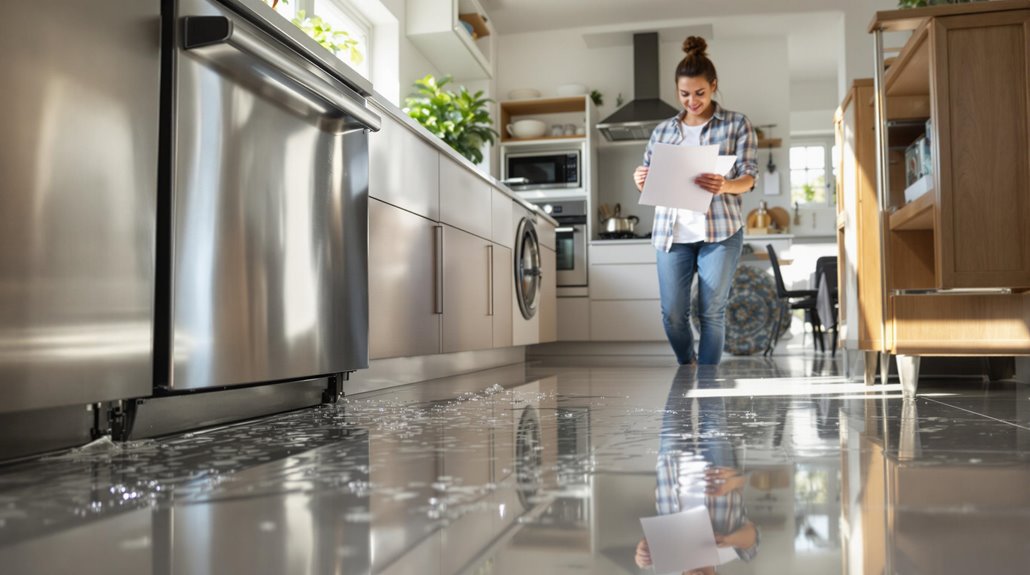
Understanding key insurance policy terms and definitions is essential for homeowners to navigate their coverage effectively. Among the fundamental components, dwelling coverage protects the home's structure, while personal property coverage safeguards belongings.
Policy exclusions specify what losses aren't covered, and coverage limits establish maximum payout amounts for claims.
Several valuation methods determine claim payments. Replacement cost provides funds to replace damaged property with new items, while actual cash value factors in depreciation.
The declarations page outlines basic policy information, including premiums and coverage specifics. Named peril policies cover only specifically listed events, unlike all-risk policies.
Endorsements modify coverage by adding or removing specific protections, such as equipment breakdown coverage. Understanding these terms helps homeowners assess their coverage needs and make informed decisions about additional protection through supplemental policies or endorsements.
Filing a Claim for Appliance Water Damage

Filing an insurance claim for appliance water damage requires careful attention to procedure and documentation. Homeowners must immediately contact their insurer upon discovering damage and take reasonable steps to prevent further water damage.
Understanding common claim denial reasons, such as negligence or lack of maintenance, helps guarantee successful claims processing.
Key elements for filing a water damage claim include:
- Documenting the damage with detailed photos and videos
- Maintaining records of all appliance maintenance and repairs
- Gathering repair estimates from qualified contractors
- Preserving damaged items for adjuster inspection
- Creating a detailed inventory of affected personal property
Following proper appliance maintenance tips, such as regular inspections and prompt repairs, strengthens the validity of future claims.
When filing, homeowners should understand their policy's specific coverage limits, exclusions, and requirements for equipment breakdown coverage.
Professional assessment and restoration services can provide additional documentation to support the claim process and validate the extent of damages.
Preventive Measures to Protect Your Home
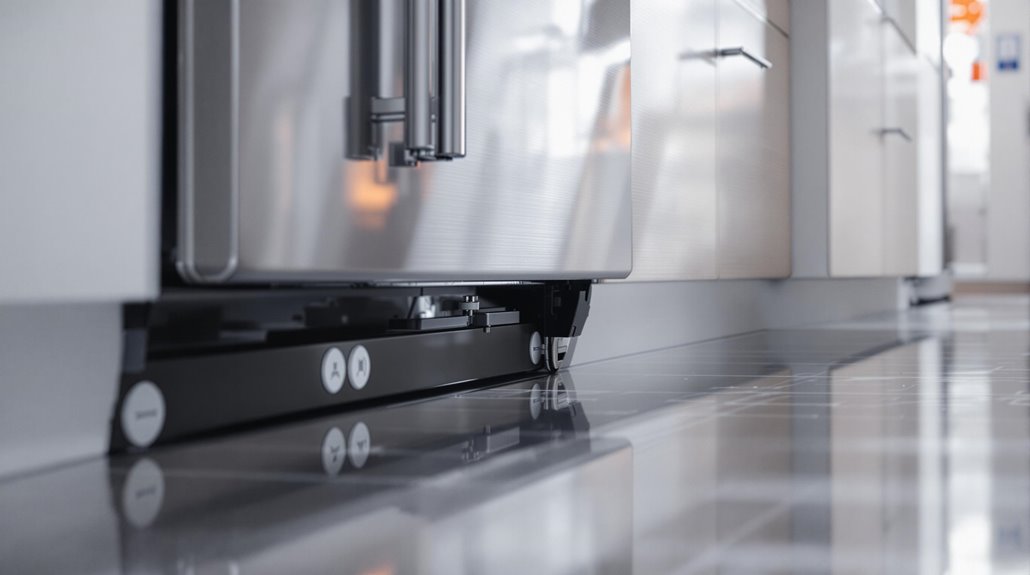
Protecting homes from water damage requires a detailed system of preventive measures across exterior, interior, and appliance-based defenses. Homeowner resources emphasize the importance of regular maintenance schedules, including seasonal inspections of critical systems and monthly checks of potential problem areas.
Exterior preventative DIY measures focus on proper drainage through well-maintained gutters, downspouts, and grading that directs water away from the foundation.
Interior protection involves installing water detection sensors, maintaining adequate ventilation, and using water-resistant building materials in vulnerable areas.
For appliances, regular inspection of hoses and connections, coupled with proper installation and maintenance, greatly reduces leak risks.
Critical components of this preventive strategy include sump pumps with battery backups, French drains for exterior water management, and automatic shutoff systems that halt water flow when leaks are detected.
Implementing these measures, along with adhering to seasonal maintenance schedules, creates a thorough defense against potential water damage.
Maintenance Requirements for Coverage
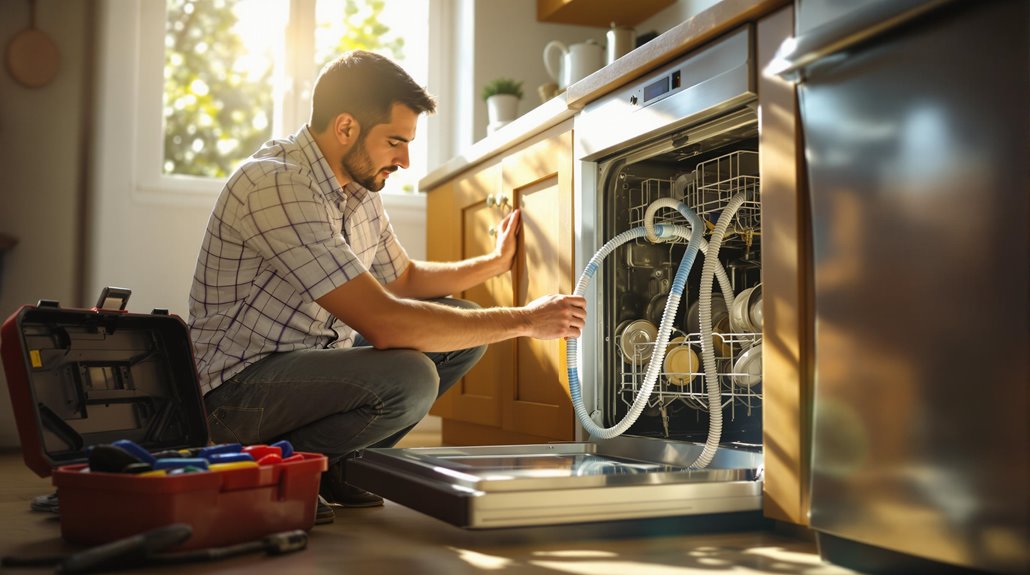
Most home insurance policies mandate specific maintenance requirements for water damage coverage to remain valid. Regular appliance maintenance and prompt attention to potential issues are essential components of meeting coverage requirements.
Insurance providers expect homeowners to demonstrate responsible care of their plumbing systems and water-connected appliances.
Key maintenance requirements include:
- Regular inspection of appliance hoses and connections
- Immediate repair of known leaks or plumbing issues
- Proper installation of all water-connected appliances
- Documentation of professional maintenance services
- Routine checks of water pressure and plumbing systems
Failure to meet these maintenance obligations can result in claim denial, particularly if damage occurs due to neglect or deferred maintenance.
Insurance adjusters specifically evaluate maintenance records and the condition of appliances when investigating water damage claims. Homeowners must understand that coverage extends only to sudden and accidental damage, not issues arising from poor maintenance practices or gradual deterioration.
When Insurance Won't Cover Appliance Leaks
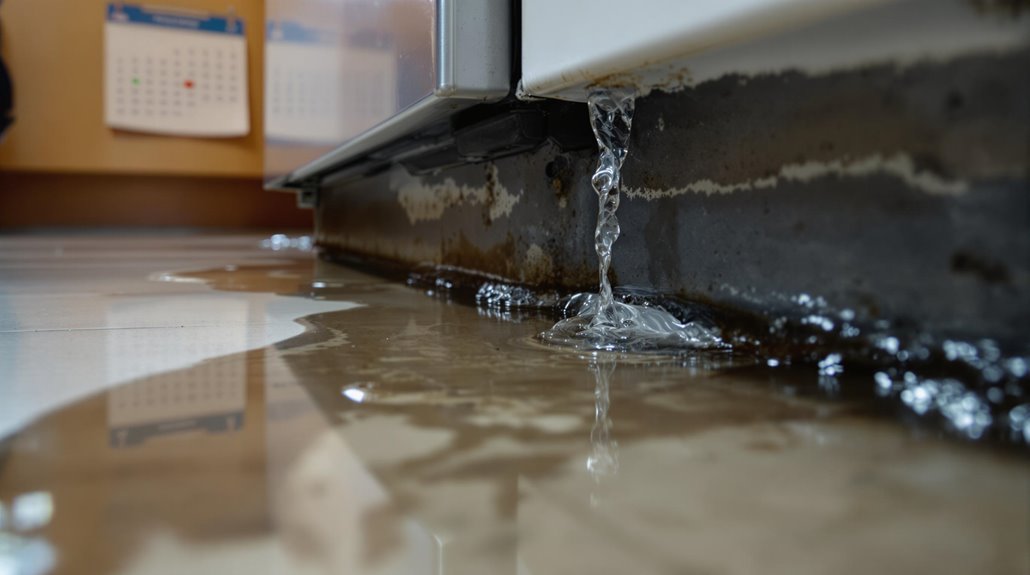
Insurance companies commonly deny coverage for appliance leaks that result from gradual deterioration over time rather than sudden events.
Claims are also typically rejected when homeowners knew about leaks but failed to address them promptly, allowing further damage to occur.
Poor maintenance history, including failure to perform regular upkeep and inspections of appliances, provides insurers with grounds to refuse coverage for resulting water damage.
Gradual Deterioration Issues
When water damage occurs gradually over time, homeowners often discover that their insurance policies exclude coverage for these types of losses.
Standard policies specifically exclude gradual damage resulting from wear and tear, corrosion, rot, or persistent moisture issues. Implementing proper maintenance schedules is essential for preventing costly repairs and ensuring insurance validity.
Common examples of excluded gradual deterioration include:
- Leaking shower trays with deteriorated sealant
- Corroded pipes causing hidden water damage
- Long-term mildew and dampness issues
- Rotting wooden structures
- Seepage from worn caulking and seals
Insurance companies require homeowners to demonstrate reasonable care through regular inspections and prompt repairs.
While standard policies focus on sudden and accidental losses, some insurers offer specialized endorsements for specific types of gradual damage, though these typically require additional premium payments.
Known But Ignored Leaks
Failing to address known water leaks can result in costly insurance claim denials. Standard homeowners insurance policies explicitly exclude coverage for water damage resulting from leaks that were known but ignored. This exclusion extends to damage caused by wear and tear, lack of maintenance, or pre-existing conditions.
Water leak prevention and homeowner responsibilities are critical factors in maintaining insurance coverage eligibility. Insurance providers require that leaks be sudden and accidental to qualify for coverage. Claims may be denied if there is evidence of prior knowledge or negligence regarding the leak.
Insurers typically won't cover damage from worn appliances, structural issues that existed before policy issuance, or situations where proper maintenance was neglected. Prompt attention to leaks and regular maintenance are essential to prevent coverage disputes and protect against potentially uncovered water damage.
Poor Maintenance History
Maintaining a thorough record of appliance upkeep and repairs plays an essential role in securing insurance coverage for water damage claims. Insurance providers scrutinize maintenance history when evaluating claims, and poor maintenance can lead to denied coverage.
Regular documentation of preventive measures and repairs demonstrates responsible homeownership and strengthens claim validity.
Key maintenance aspects affecting insurance implications:
- Timely replacement of worn-out appliance parts and hoses
- Regular inspection of plumbing systems and connections
- Prompt response to minor leaks before escalation
- Installation and maintenance of required safety features like drip pans
- Documented professional servicing and repairs
When homeowners neglect routine maintenance, insurers may determine that resulting water damage was preventable, leading to claim denial.
This applies particularly to gradual damage from slow leaks or deteriorating components that should have been addressed during regular maintenance.
Steps to Document Water Damage
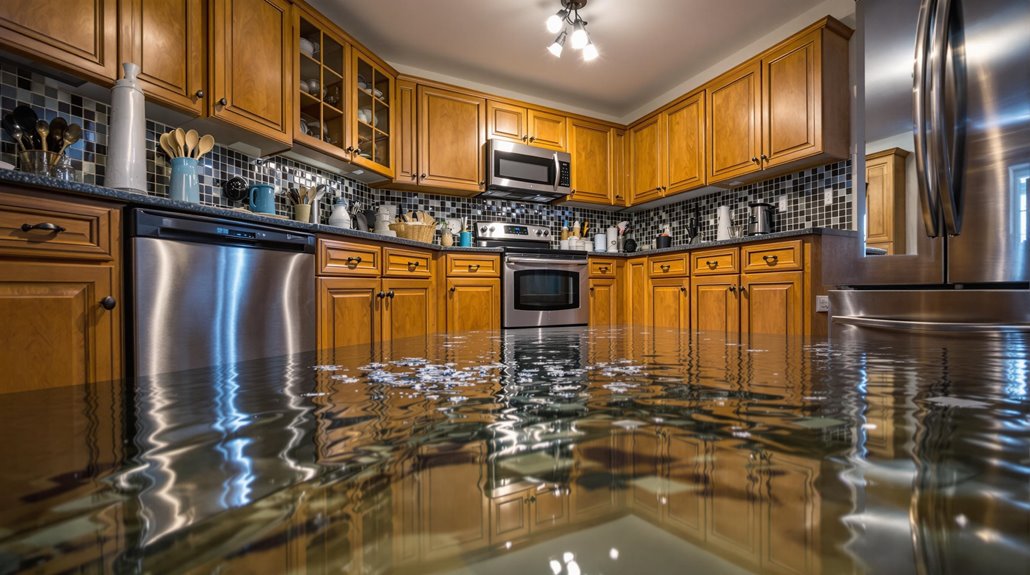
Documenting water damage thoroughly serves as a critical first step in filing an insurance claim and ensuring proper compensation. The documentation process begins with notifying the insurance provider and securing the property by stopping the water source and mitigating further damage.
Visual documentation requires extensive photography and videography of the affected areas, capturing both overview shots and detailed close-ups from multiple angles. Property owners should focus on the damage source and maintain clear, well-lit images of all impacted structures and belongings.
Essential record-keeping includes creating a detailed inventory of damaged items, preserving evidence for the insurance adjuster's review, and maintaining receipts for related expenses.
A thorough incident report should detail the event's timeline, cause, and immediate actions taken. The report should incorporate visual evidence, inventory lists, and restoration efforts, establishing a complete record for the claims process.
Tips for Choosing the Right Coverage
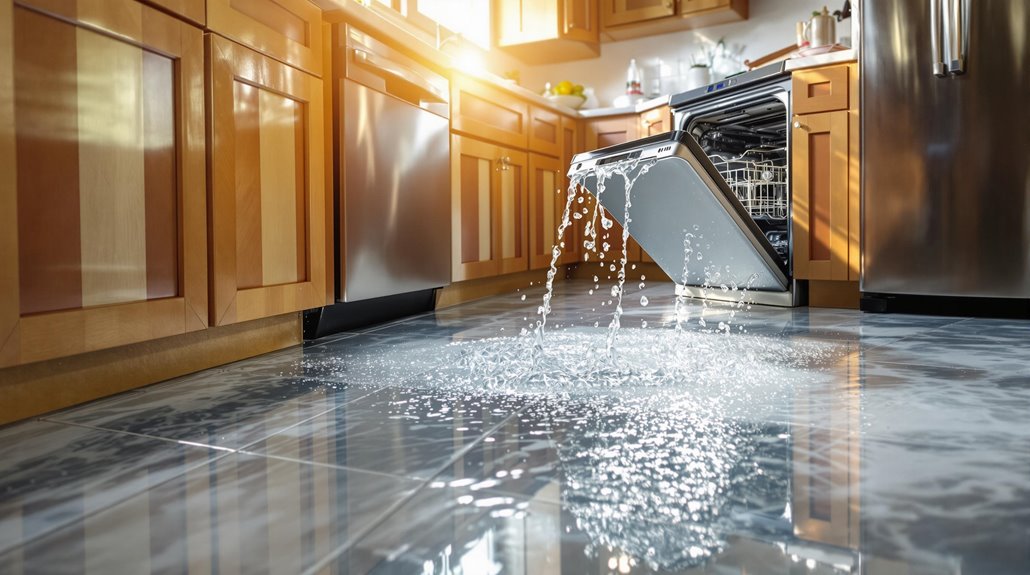
When selecting water damage coverage, homeowners should evaluate which endorsements provide protection against specific risks like sump pump failures and equipment breakdowns.
The selection of appropriate deductible levels requires careful analysis of financial capacity and risk tolerance, as higher deductibles typically result in lower premiums but greater out-of-pocket expenses during claims.
Insurance providers offer various coverage options and endorsements that can be customized to address specific water damage concerns while staying within budget constraints.
Evaluate Coverage Endorsements Needed
A thorough evaluation of coverage endorsements is essential for homeowners seeking adequate protection against water damage. When examining potential endorsements, consider both standard coverage for appliance leaks and additional protections available through specialized endorsements.
Key factors to evaluate when selecting water damage coverage endorsements:
- Coverage limits ranging from $5,000 to full replacement cost
- Annual premium costs between $50 and $250 for water backup protection
- Inclusion of mold damage caused by water-related incidents
- Protection against sump pump failures and sewer line backups
- Coverage for damages beyond standard policy exclusions
Understanding these endorsement options enables homeowners to make informed decisions about supplemental coverage needs.
Careful consideration of potential risks, coverage limitations, and cost-benefit analysis helps determine the most appropriate endorsements for extensive protection against water-related damages.
Compare Deductible Options First
Selecting appropriate deductible options represents a critical first step in securing ideal water damage coverage for homeowners. A thorough deductible comparison must evaluate both dollar-amount and percentage-based structures, weighing their impact on premium costs against potential out-of-pocket expenses during claims.
Effective deductible strategies consider multiple factors, including the home's value, location-specific risks, and the homeowner's financial stability. Those with robust emergency funds may opt for higher deductibles to reduce premiums, while homes in areas prone to water damage might benefit from lower deductibles to manage frequent claims.
Special consideration should be given to flood deductibles in high-risk areas, which typically follow a dollar-amount structure. The final selection should balance affordability with the practical ability to pay the chosen deductible when filing a claim.
The Benefits Of Consulting A Public Adjuster
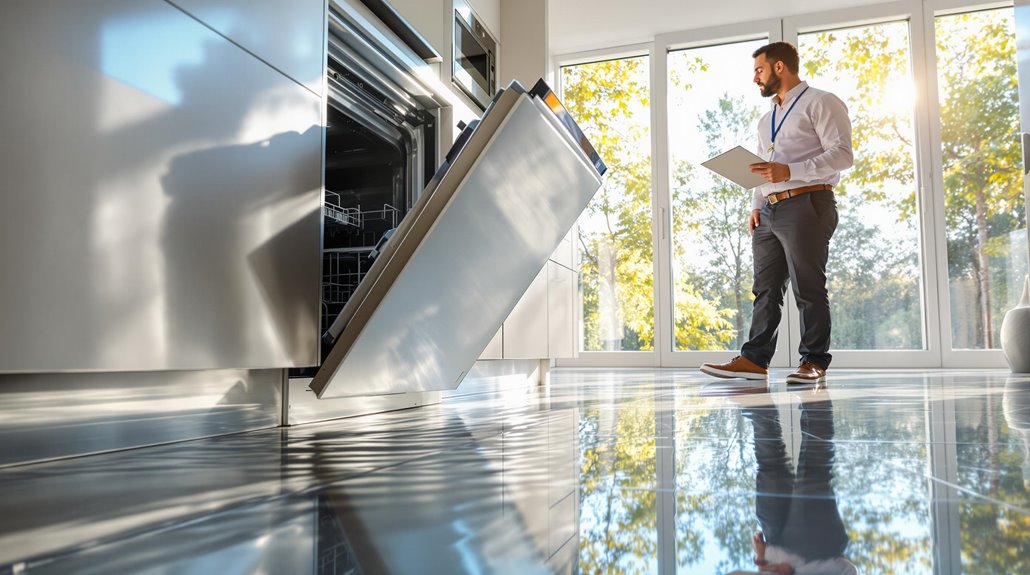
When dealing with water damage insurance claims, public adjusters offer specialized expertise and maintain objectivity throughout the assessment process.
These licensed professionals streamline claim procedures by managing documentation, negotiations, and communications with insurance carriers.
Studies indicate that claims handled by public adjusters typically result in higher settlements compared to those filed directly by homeowners, due to their thorough understanding of policy terms and professional negotiation skills.
Expertise In Insurance Claims
Public adjusters provide invaluable expertise in traversing the complex landscape of insurance claims, offering professional guidance through every step of the water damage claims process. Their insurance claim strategies encompass thorough understanding of policy terms, documentation requirements, and negotiation techniques essential for policyholder advocacy.
Key areas of expertise include:
- Detailed interpretation of policy coverage and exclusions
- Strategic documentation gathering and damage assessment
- Professional estimation of repair costs and loss values
- Skilled negotiation with insurance companies
- Maximum settlement optimization through evidence-based claims
Their knowledge of state-specific regulations and insurer practices enables them to navigate complex claims effectively while ensuring policyholders receive fair compensation.
This expertise proves particularly valuable in water damage cases, where proper documentation and timely response are vital for successful outcomes.
Objective Damage Assessment
Obtaining an objective assessment of water damage through a public adjuster consultation offers significant advantages for property owners seeking accurate claim settlements.
Public adjusters provide skilled claim representation, ensuring thorough documentation of all damages, including those that might be overlooked during routine inspections.
These professionals conduct extensive damage assessments, meticulously gathering evidence and preparing detailed documentation to support insurance claims. Their expertise in identifying the full scope of water damage enables accurate valuation of losses and necessary repairs.
Through skilled negotiation with insurance companies, public adjusters leverage their knowledge to secure maximum settlements for policyholders. Their contingency-based compensation model aligns with the policyholder's interests, motivating them to achieve ideal claim outcomes through detailed assessment and effective representation.
Streamlined Claim Process
Engaging a public adjuster can dramatically streamline the insurance claims process for water damage by providing efficient communication channels and expert claim management services.
These professionals offer extensive claim assistance, handling all interactions with insurance companies while guaranteeing proper documentation and timely submission of evidence.
- Manages complete communication with insurance carriers, eliminating homeowner stress
- Coordinates directly with contractors for repair estimates and scheduling
- Applies expert knowledge of insurance policies and local regulations
- Conducts objective negotiations to maximize settlement outcomes
- Maintains thorough documentation and tracks critical deadlines
Through skilled insurance negotiation, public adjusters expedite the claims process while reducing the emotional and time burden on homeowners.
Their expertise in policy interpretation and damage assessment guarantees compliance with regulations while maximizing the potential settlement value of water damage claims.
Higher Claim Payouts & Settlements
Most homeowners seeking settlements for water damage claims receive substantially higher payouts when working with public adjusters compared to filing independently.
Statistical evidence from the Florida Association of Public Insurance Adjusters demonstrates that professionally adjusted claims yield approximately 19% higher settlements, with average payouts of $22,266 versus $18,659 for self-filed claims.
Public adjusters employ strategic claim negotiation strategies and settlement maximization techniques, leveraging their expertise in policy interpretation and damage assessment.
Working on a contingency basis, these professionals are incentivized to secure ideal settlements. Their understanding of insurance company tactics, combined with thorough documentation practices and skilled advocacy, guarantees that all covered damages are properly valued.
This expertise enables them to counter insurance companies' settlement reduction strategies effectively, resulting in more favorable outcomes for policyholders.
About The Public Claims Adjusters Network (PCAN)
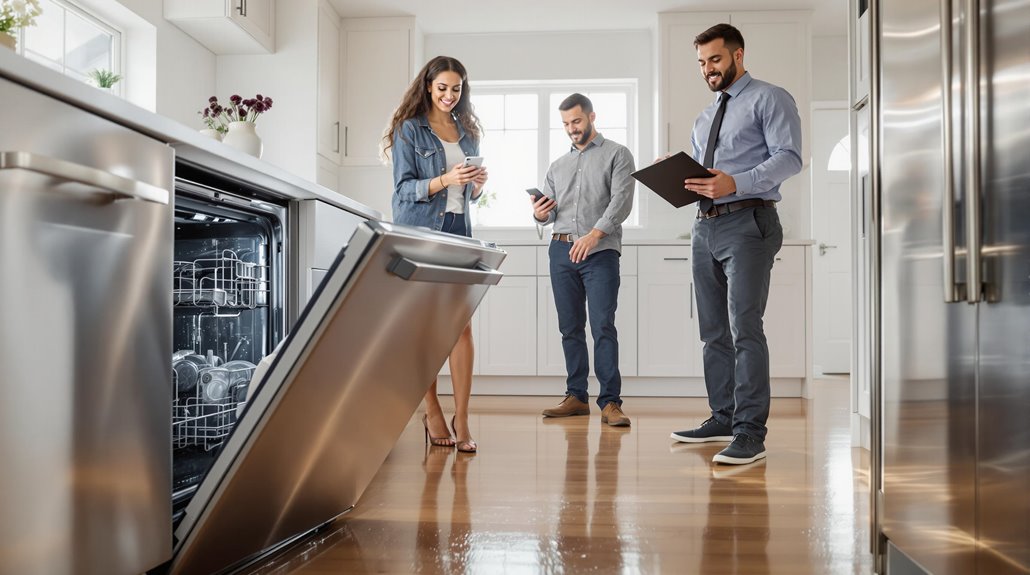
The Public Claims Adjusters Network (PCAN) serves as a thorough alliance of independent insurance claims professionals who specialize in maneuvering the complexities of the claims process. Their claims adjuster roles encompass all-encompassing solutions for both daily and catastrophic claims, emphasizing claims process efficiency through seasoned expertise and adaptable strategies.
Key attributes of PCAN include:
- Immediate support via dedicated call centers for first notice of loss
- Professional handling of routine and complex insurance claims
- Customized solutions tailored to specific operational challenges
- Expertise derived from decades of industry experience
- Enhanced claim outcomes through strategic management
PCAN has established itself as an industry benchmark setter, consistently delivering professional and empathetic service while maintaining high standards in claims management.
Their network of adjusters brings extensive knowledge to every case, transforming traditional claims processes through innovative approaches and reliable solutions, particularly in complex claim situations requiring specialized attention.
Frequently Asked Questions
Does Upgrading to Water-Efficient Appliances Reduce My Insurance Premium?
Installing water-efficient appliances can reduce insurance premiums through specific discounts, as these upgrades minimize water damage risks and demonstrate responsible homeownership to insurance providers seeking to minimize claim potential.
Can I Choose My Own Repair Contractor After Filing a Water Damage Claim?
Want control over repairs? While policyholders may select their own repair contractor, insurance policies often specify claim process guidelines, potentially limiting repair contractor options or requiring approval for non-network professionals.
Are Smart Water Detection Devices Worth Installing for Insurance Discount Purposes?
Smart water detection devices deliver quantifiable smart home benefits through insurance discounts up to 15% while providing active water leak prevention, making the investment financially advantageous when factoring long-term savings.
Does Insurance Cover Damage to Neighboring Units From My Appliance Leak?
Standard homeowners insurance typically covers neighbor liability for sudden, accidental appliance leaks. However, insurance exclusions apply for gradual leaks, poor maintenance, or negligent behavior by the policyholder.
How Long After Purchasing New Appliances Should I Update My Policy Coverage?
Like maintaining a ship's manifest, policy updates aren't immediately required for new appliances. Annual reviews suffice unless appliance warranties expire or high-value purchases considerably increase the home's worth.



